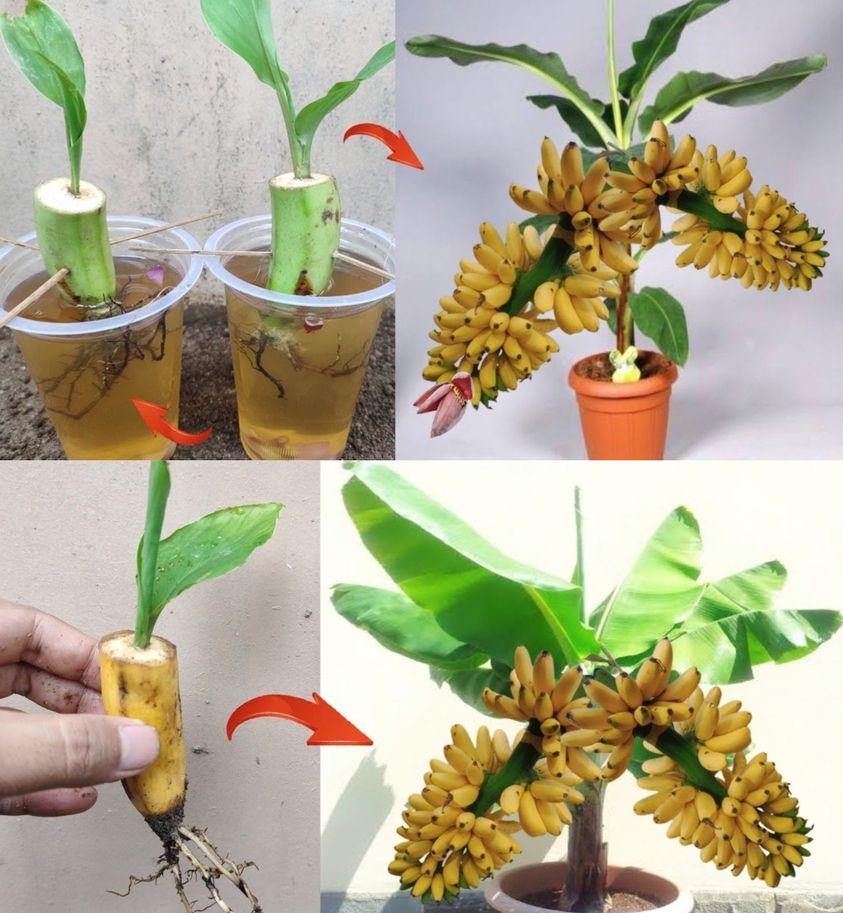Growing bananas in pots is very easy and accessible to everyone. And the result is spectacular, because even if we don’t achieve big harvests, we will have a decorative shrub with large leaves that spreads the tropical air everywhere. Learn how to plant and care for them in this step-by-step article.

It doesn’t matter if you live in a tropical climate, you can grow and care for your bananas yourself in pots. If you start growing the normal variety, the banana tree can reach a height of 10 to 15 meters, but if you have a dwarf banana, it will not reach more than 3 meters in height.
Banana varieties to grow in pots.
These species of dwarf bananas are only 1.5 m to 3 m long. (4 to 12 feet) tall and suitable for growing in containers. You can also grow these banana varieties indoors.
- Red Dwarf
- Dwarf Cavendish
- Brazilian Dwarf
- Jamaican Dwarf
- Rajapuri
- Williams Hybrid
- Grand Naïn
- Nain “Lady Finger”
If you want to grow ornamental bananas, check out these varieties:
- ensète ventrikosum
- Musa sikkimensis “red tiger”
- Ornate Muse
Soil requirements for growing bananas in pots.

- Banana trees need sandy, well-drained soil that is very fertile and rich in organic matter.
- Enrich the soil with organic or natural compost.
- It is recommended to use good quality commercial pots instead of garden pots.
- But don’t buy normal heavy pots, instead choose flower pots for cacti or palm trees, which is a great choice for containerized bananas.
- To prepare homemade potting soil, mix equal amounts of sand, perlite, or vermiculite with compost or manure.
- The pH of the soil should be between 6.0 and 7.0. To balance the pH, use sulfur to lower the pH.
- The banana tree prefers slightly sour to neutral to produce flavorful bananas.
Climate suitable for growing bananas in pots.

- Banana plants generally need warm subtropical or tropical climates to thrive. Banana plants can tolerate extreme heat with a good amount of water.
- Bananas can withstand the cold for a short time, but when the temperature drops below 14°C, the tree stops growing.
- In cooler regions, as temperatures drop, the leaves turn yellow and the fruit skin turns gray.
- The banana tree in the containers can die at any time, in winter it is best to take the containers home.
- The ideal temperatures for growing bananas in pots are 26°C to 30°C.
Humidity for potted bananas.
The banana tree prefers a humidity of more than 50%. To keep moisture all around the plant, mist the plant and place it in a container filled with water on a layer of pebbles.
The right pot size.

- Bananas need a wide and deep container to grow.
- Choose a medium-sized container with a hole to grow bananas in containers.
- The ideal container size for bananas is 6 to 8 inches deep and 5 inches wide.
- Don’t forget that the depth that is going to be done plays a crucial role, as the roots of the banana need a good place to grow.
- The container can be made of ceramic, plastic, metal or a wooden pot. The use of clay pots is highly recommended.
- Bananas can be transplanted after 1 to 3 years.
Irrigation.
- Bananas love moisture. Water regularly and thoroughly, but be careful not to overwater.
- Water every day in the summer. In hot weather or with root attachment, it may even need to be watered twice a day. The soil for growing banana trees should be kept evenly moist. Reduce watering in winter.
Fertilizer.
- Use fertilizers rich in magnesium, potassium and nitrogen.
- Use a water-soluble fertilizer or sprinkle granular fertilizer on the soil without touching the main stem.
- Fertilize the young plant, if it is well established, with a nitrogen-rich fertilizer to help it grow faster.
- Once your potted banana tree is mature enough to produce fruit, fertilize it regularly with NPK fertilizer: .
Pests and diseases.
- Bananas are quite resistant to disease, even if the leaves turn brown and dry out at the edges, all of this means that you are overwatering and if the leaves turn yellow, the banana tree lacks nutrients.
- Some pests that could infect the banana tree are aphids, banana weevils, and coconut mealybug. These pests can be easily repelled with organic pesticides.
Thank you for reading this article, we are sure that from now on you will be able to grow the banana tree you have been dreaming of having at home.

